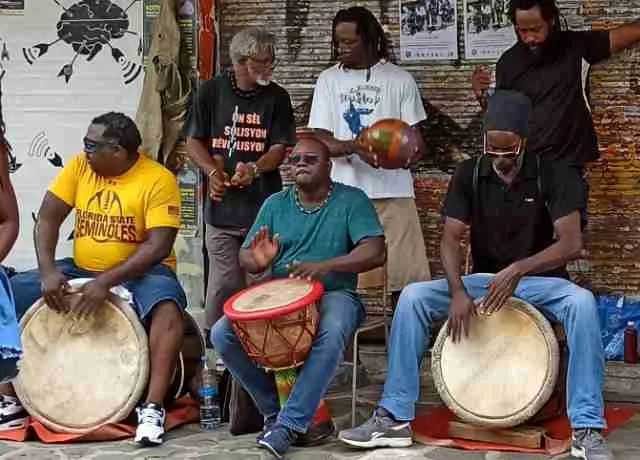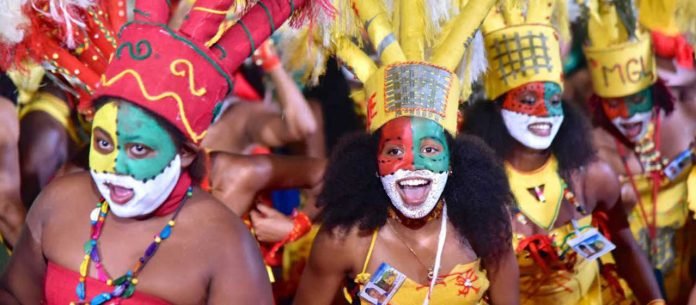Guadeloupe’s culture is a captivating blend of French and Creole influences. Guadeloupe’s Carnaval celebrations and it’s festivities, such as Carnaval and Fête des Cuisinières, showcase the island’s rich cultural tapestry through music, dance, and culinary traditions. In this article we explore we the exuberance and sheer joy of the festivities of Guadeloupe.
The Melody of Creole Music
In Guadeloupe, music is more than just entertainment; it is an expression of the island’s soul. Genres such as Gwo Ka, Zouk, and Kadans are deeply rooted in Guadeloupe’s heritage. Gwo Ka, in particular, is a traditional form of music and dance that originated with the enslaved Africans brought to Guadeloupe. It involves percussive rhythms played on a set of drums known as Ka, and UNESCO has recognized it as a form of intangible cultural heritage.
Evocative Storytelling through Music
The music of Guadeloupe, especially Gwo Ka, is more than just rhythm and melody—it is a form of storytelling. Lyrics often recount the struggles of the island’s past, including slavery and colonization, and carry powerful messages of resistance, resilience, and hope. In addition, Gwo Ka is often improvisational, allowing musicians and dancers to engage in a dynamic, living conversation with each other and with the audience.

Instruments and Voices
Beyond the Ka drums, Guadeloupean music incorporates a variety of other instruments, such as the chacha (a percussion instrument), the tanbou bas (bass drum), and the syak (a type of rattle). Voices are also a critical element. The lead singer, or “kané,” guides the song with a strong, soulful melody, while the “responders” follow with harmonious, call-and-response singing, a style that is deeply rooted in African musical traditions.
Influence and Evolution
Today, Guadeloupean music continues to evolve, blending traditional elements with modern genres such as jazz, reggae, and hip-hop. This fusion not only preserves the island’s rich musical traditions but also keeps them fresh and relevant for new generations. It serves as a powerful bridge between the past and the present, the local and the global.
The Color and Spirit of Carnaval
Carnaval is one of the most anticipated events in cultural calendar and Guadeloupe’s Carnaval celebrations maintain a legendary energy. It begins in January and reaches its peak in February with a grand parade. During this period, the island pulses with vibrant colors, intricate costumes, and rhythmic beats. Participants, called Carnavaliers, dance through the streets of towns and cities, embodying various characters that reflect the island’s history and culture.
Symbolism in Costumes and Masks
Each costume and mask worn during Carnaval is rich with symbolism. Colors are chosen carefully to represent various aspects of Guadeloupe’s history and identity. For example, red often symbolizes the blood of the ancestors, while green represents the island’s lush vegetation. Masks can portray specific historical figures or broader archetypes, challenging or celebrating different aspects of society and human nature.
Community and Celebration
Carnaval is a profound communal experience. It brings together people of all ages and backgrounds, fostering a sense of unity and shared joy. The event is not exclusive to any one group; rather, it is a celebration of the rich and diverse culture of Guadeloupe as a whole. For the people of Guadeloupe, Carnaval is not just a party; it’s a key expression of national identity.
Endings and New Beginnings
The Carnaval festivities culminate in the ritual burning of “Vaval,” an effigy that symbolizes the spirit of Carnaval. This act marks the end of the festive period and the beginning of Lent. It is a poignant moment, blending elements of celebration, purification, and renewal—a fitting end to a festival that encapsulates so much of Guadeloupe’s vibrant culture and history.
In essence, both the Creole music and the Carnaval of Guadeloupe are not just celebrations but are integral components of the island’s identity, reflecting its complex history, its rich cultural heritage, and its resilient and vibrant spirit.
Fête des Cuisinières: A Culinary Tribute
Every August, Guadeloupe pays homage to its culinary traditions with the Fête des Cuisinières, or Festival of Women Cooks. This event is a grand celebration of Creole cuisine and the women who have mastered it. Participants, dressed in traditional Creole attire complete with colorful headscarves and aprons, parade through the streets and later gather to bless their utensils in a church ceremony. The festival culminates in a grand feast where mouth-watering dishes such as colombo de poulet (chicken curry) and accras de morue (saltfish fritters) are shared.
Honoring the Matriarchs
The Fête des Cuisinières is more than just a celebration of food—it is a tribute to the matriarchs of Guadeloupean families, who have long been the keepers of the island’s culinary traditions. These women are honored for their role in preserving and passing down recipes that have sustained families and communities for generations. They are celebrated as artists and historians, whose hands shape not just nourishing meals, but also the cultural memory of the island.
The Blessing Ceremony
One of the most significant parts of the festival is the blessing of the cooking utensils in a church ceremony. This sacred ritual symbolizes the deep respect that Guadeloupeans have for the act of cooking, recognizing it as a form of caregiving and a spiritual practice in its own right. The blessing is a powerful expression of gratitude—for the food, for the hands that prepare it, and for the rich culinary traditions that are a cornerstone of Guadeloupean culture.
Fusion of Flavors and Cultures
The grand feast that is the centerpiece of the Fête des Cuisinières showcases the incredible diversity of Guadeloupean cuisine. A fusion of African, French, Indian, and Amerindian influences, the island’s food is a flavorful tapestry that tells a story of migration, resilience, and creativity. The colombo de poulet, for example, is a rich curry that reflects Indian and Southeast Asian influences, adapted with local spices and ingredients.
Traditional Attire and Parade
The vibrant parade that marks the Fête des Cuisinières is a visual feast. Participants, predominantly women, dress in traditional Creole attire—madras fabric dresses, colorful headscarves known as ‘tête en l’air’, and pristine white aprons. The outfits are not just beautiful; they are also deeply symbolic, reflecting a blend of African heritage and colonial history. The parade is a moving tribute, a chance for the women to proudly display their heritage and the central role they play in Guadeloupean society.
Community and Sharing
The Fête des Cuisinières is, at its core, a communal celebration. After the parade and the blessing ceremony, everyone—locals and visitors alike—is invited to partake in the grand feast. This aspect of sharing is fundamental. It’s not just about enjoying delicious food; it’s about coming together as a community, breaking bread with neighbors, and welcoming strangers as friends. The festival embodies the Creole concept of ‘conviviality’, the joy and warmth of being together, which is central to Guadeloupean culture.
In essence, the Fête des Cuisinières is not only a celebration of Guadeloupe’s extraordinary culinary heritage but is also a profound tribute to the women who are the heart and soul of that tradition. It is an event where history, culture, spirituality, and community come together in a vibrant and flavorful expression of Guadeloupean identity.
Craftsmanship and Artistry
The people of Guadeloupe are renowned for their craftsmanship. From intricate madras fabric (a brightly colored, plaid-patterned material) used in traditional dress to stunning works of pottery in the village of Saint-Jean, the island’s artisans create beautiful, tangible representations of their culture. These crafts are more than just souvenirs; they are pieces of Guadeloupe’s soul, shaped by the hands of its people.
Tradition and Modernity in Harmony
In Guadeloupe, craftsmanship is both an homage to tradition and a space for innovation. While artisans continue to use time-honored techniques and natural materials, they also infuse their work with modern touches. Whether it is through experimenting with new designs in pottery or integrating contemporary themes in fabric patterns, the artisans of Guadeloupe create works that are both rooted in history and relevant to today.
Empowerment and Livelihood
For many artisans, their craft is not just an art—it is a livelihood. The act of creating and selling these pieces provides economic empowerment, especially for women and rural communities. Additionally, craftsmanship plays a role in sustaining and revitalizing local economies, attracting tourists who are eager to bring home a piece of Guadeloupe.
Language: A Reflection of History
While French is the official language, Creole is the heart language of the locals. A rich, expressive language that emerged during the colonial period, Creole is a blend of French with African, Amerindian, and other influences. It stands as a testament to the island’s complex history and the resilience and adaptability of its people.
Preservation and Education
The preservation of Creole is an act of cultural resilience. Despite its unofficial status, efforts are being made to integrate Creole into educational systems, ensuring that future generations can speak and appreciate this rich language. Literature, poetry, and music in Creole flourish, reflecting a vibrant and living linguistic culture.
Theatrical and Literary Scene
Guadeloupe has a vibrant literary and theatrical scene, with numerous local playwrights and authors gaining international recognition. Maryse Condé, for instance, is a celebrated author whose works explore themes of cultural identity and the legacy of colonialism. Her novel Segu is acclaimed worldwide.
Spotlight on New Voices
In addition to established writers like Condé, Guadeloupe is also home to a new generation of writers and playwrights whose works are beginning to gain attention both locally and internationally. These new voices are using their platforms to explore contemporary issues, such as social justice, gender, and environmental conservation, from a uniquely Guadeloupean perspective.
Spiritual Tapestry
Guadeloupe’s spiritual life is a blend of Catholicism, inherited from French colonization, and Afro-Caribbean beliefs, a legacy of the island’s African heritage. This rich spiritual tapestry is evident in the island’s many churches and the more traditional léwoz ceremonies, which are musical gatherings deeply rooted in Guadeloupe’s African past.
Harmony and Syncretism
In Guadeloupe, different spiritual traditions often exist in harmony and sometimes blend in fascinating ways. This syncretism can be seen in the way Catholic saints are sometimes identified with African deities in local practices, and how traditional léwoz ceremonies can carry elements of both African spirituality and Christian symbolism.
Spaces of Worship and Community
Whether it’s in the grandest cathedral in Pointe-à-Pitre or a humble, makeshift altar in a rural home, the spaces of worship in Guadeloupe are as diverse as the beliefs they house. These spaces are not just places for spiritual practice; they are also centers of community life where people come together to celebrate, mourn, and support one another.
In essence, the craftsmanship, language, arts, and spirituality of Guadeloupe are not isolated aspects of the island’s culture. Instead, they are interwoven threads that, together, create the vibrant, resilient, and multifaceted tapestry of Guadeloupean life and identity.
Conclusion
In Guadeloupe, culture is not just observed; it is lived. Whether through the rhythm of drums, the flavors of its cuisine, or the vibrant patterns of madras fabric, the island invites visitors to experience and engage with its cultural vibrance in a profound and authentic way. For the discerning traveler, this offers an immersive journey into the heart of what makes Guadeloupe truly unique.


















